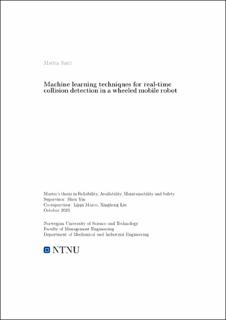| dc.description.abstract | This thesis focuses on the application of various machine learning (ML) techniques to
improve the overall dependability of a wheeled mobile robot (WMR) control during a
real-time simulation.
The whole system consists on a WMR, provided by the company ’Quanser’, and a related
ground station that represents a Digital virtual twin of the device, which aims to control
the real-time simulation of the robot.
The control model of the WMR had already been developed in Simulink, where it was
possible to immediately carry out various experiments in order to gain some insights into
possible improvements to make the whole system safer and more reliable, which is the
aim of this work.
This was done by first extracting a large dataset containing all the signals that occurred
during the simulation. After analyzing the data, different ML models were developed in
Python that were able to identify collisions and their duration. At the end of this step,
the ML model with the highest score was selected and, as a result, a neural network
model was identified as the best one.
The neural network was then exported to the robot’s Simulink Digital twin, allowing the
model’s performance to be verified in real-time during the simulation.
The main objective of this work was to prevent the robot from malfunctioning and to
enable the bumper to react appropriately even in such situations.
Since it makes sense that the sensors would lose their ability to work properly after a
certain period of time, the ML models developed aim to work in a real-time simulation
in parallel with the standard model, which includes the output of the sensors, in order
to make the device more resistant to sudden failures and able to act as if these failures
were not occurring.
In industrial applications, the robot’s sensors may stop working as they should, causing
downtime and potential hazards to nearby workers.
In this way, it was possible to make the robot’s bumper sensors more reliable and safer,
behaving as if they were not affected by these faults, making the system more flexible
and durable.
The final results clearly show how the application of ML algorithms in the field of robot
control can lead to significant improvements in safety and reliability. | |
